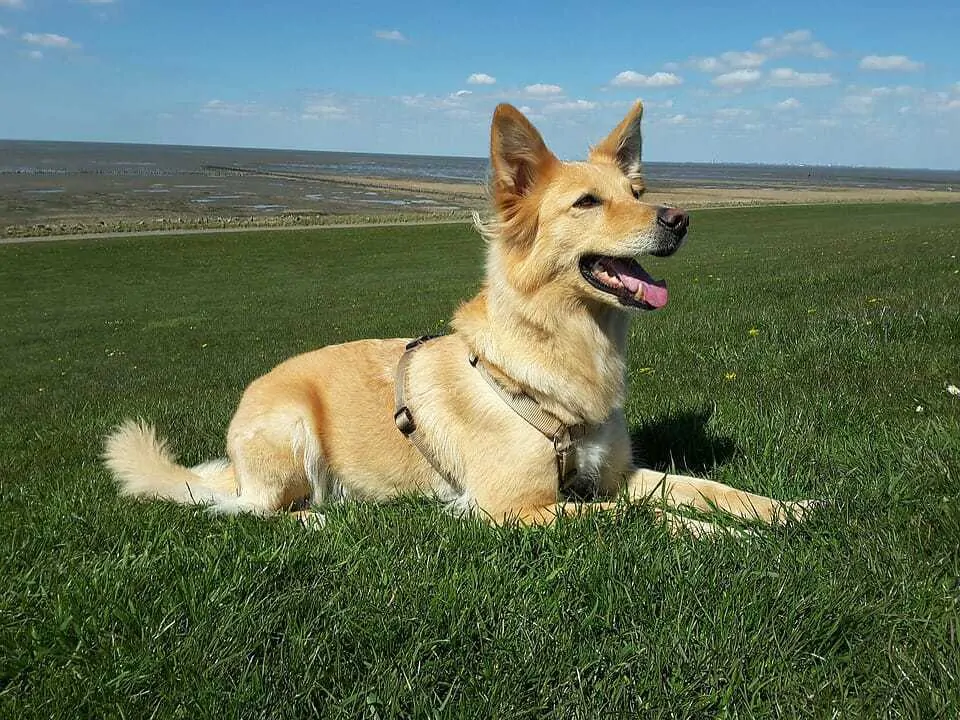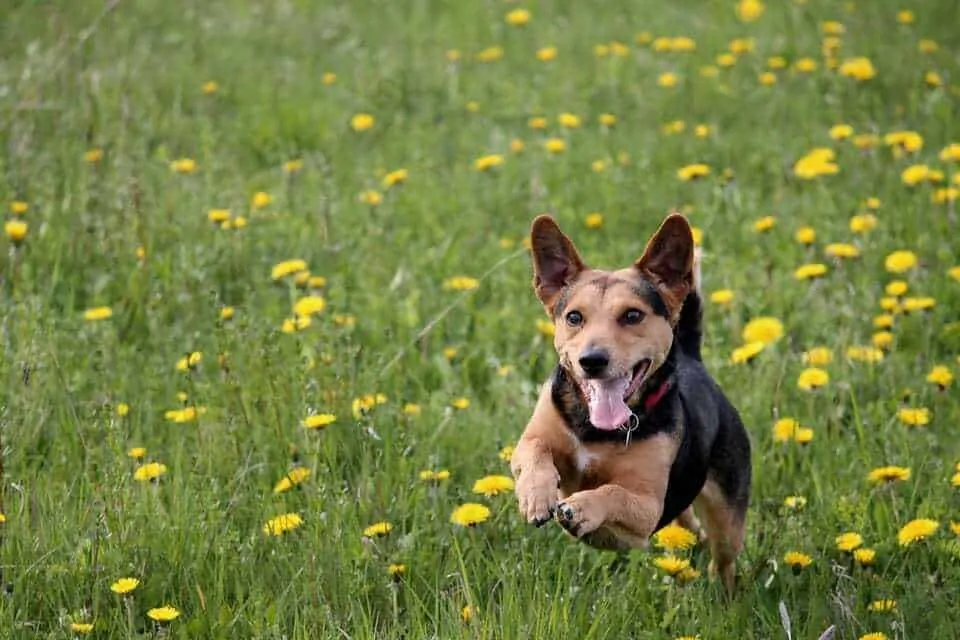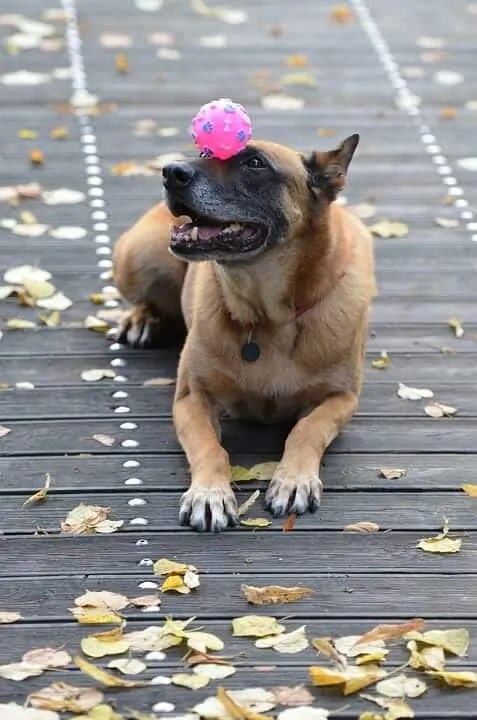When you think of positive reinforcement training, what comes to mind?
If you’re like most people, you probably said treats. Lots of yummy, high-value treats. While it’s true that rewards (whether they are treats, toys, or praise) are a huge piece of training, they aren’t the only “tools” you’ll need.
Your dog looks to you for guidance during training. Make sure you are communicating effectively by utilizing markers, cues, and release words.
In order to achieve training success, you need to be able to communicate with your dog. This means being able to tell them what you want them to do, and if they are doing it correctly or incorrectly. While this may sound straight forward, keep in mind that your furry friend doesn’t speak English.
It’s also important to remember that dogs learn best when they are calm and focused. Anything that causes anxiety will reduce your dog’s ability to comprehend what you are trying to teach them. This is one of the many reasons we don’t recommend punishment based training.
When training a new behavior, there are three tools you’ll need in addition to a motivating reward: cues, markers, and a release word. In this article, we’ll look at these three tools, how to introduce them to your dog, and how to utilize them to improve your communication and find training success.
>>>Love working with dogs? Here’s what you need to know about starting a dog sitting business.
Contents
What Are Cues
The first tools you’ll need in your training regimen are cues. Odds are, you’re already familiar with and using cues, even if you don’t recognize the term. Traditionally what we now call a cue was commonly referred to as a command. While this is technically correct, the word command tends to conjure up images of dogs being told what to do.
A cue, on the other hand, is a broader term that covers all signals, whether verbal, physical, or other. The word “cue” also has more positive connotations. Training shouldn’t be about forcing your dog to do certain things, it should be about communicating effectively to get your dog to do what you ask.
A working dog, like this herder, must recognize a variety of cues given as whistles from a distance and react with the correct behavior every time.
One cue you are probably familiar with is the word “sit.” In the most basic example of the sit cue, you would say “sit” and your dog would sit. But your cue could also be a closed fist presented in front of your dog. Or, if your dog is a working shepherd, the cue for sit might be something as complex as a series of whistles given from afar.
Cues can take many forms, but the function is always the same. They tell your dog what you are asking them to do.
Training a New Cue
As I mentioned above, your dog doesn’t speak English. I know this information probably does not come as a shock to you, but when many owners begin training, they seem to forget this fact. They tell their dog to sit, and when nothing happens, they get angry. If you give your dog a command and they don’t complete the right behavior, it’s probably because they don’t understand which behavior is associated with that particular cue.
Before you can assume your dog will complete the right behavior when a particular cue is given, you must teach your dog to associate that behavior with that cue. And before you can do that, you need to get your dog to offer the behavior you want without any cue given.
As long as you are using the right motivation, your dog should be actively trying to earn their reward by offering different behaviors. Reward them for the behavior you want and then create a cue for it and continue to reward them until they associate the behavior with the new cue.
It seems confusing and backward, but it works. Let’s take the sit behavior as an example.
First, you must train your dog to sit by taking a treat and luring them into the sitting position. Once their butt hits the floor, you give them a reward. You continue to do this until your dog will offer a sit on their own because they know that behavior earns them a reward. Once your dog is offering a sit on their own, then you add the cue.
>>>Ready to start training your dog? Don’t forget your treat pouch!
Give your chosen cue, then, once your dog sits, reward them as before. It’s important to understand that your dog didn’t sit because you gave the cue. They sat because you keep rewarding them for sitting. However, the more times you give the cue right before your dog sits, the stronger an association they’ll have between the two things.
After multiple repetitions of giving the cue and rewarding your dog for sitting, you should be able to give the cue and have your dog sit because they now associate the cue with that particular behavior. If your dog truly understands the cue, they will continue to perform that particular behavior even in different situations when they are not automatically offering the behavior.
For some simple commands, it makes sense to start using the cue right away, even as you are still shaping the correct behavior using luring or targetting. Your dog won’t actually be making the association between the cue and behavior right away, but it will help your timing as the handler.
But, for more complex behaviors, like teaching your dog to move into heel position or the place command, using the cue before the dog can complete the behavior isn’t recommended. In the beginning of the training process, the cue is just background noise. It isn’t helping your dog learn the behavior (or the cue) and may even distract them from focusing on the very complex behavior you’re trying to build.
If your dog knows a lot of tricks, you may have to get creative in what you name them (or the hand signal you use) so your pup can distinguish between each cue.
Cue Tips and Tricks
- Choose a distinct signal for each behavior so your dog doesn’t confuse two separate behaviors.
- You can combine a verbal and physical cue for one behavior if you want. As your dog associates both cues for the single behavior you can use either to get them to complete it.
- While humans are verbal creatures, canines communicate mostly in body language and most dogs will learn physical cues faster than verbal ones.
- Always be consistent with your cue. If you teach your dog to shake hands using the cue “paw,” don’t expect them to complete the behavior if you say “shake” or “give me your paw.”
What Are Markers
Imagine for a moment that you are in a room with another person who speaks a different language. You know this person would like you to complete a task, but you don’t know what that task is. You begin wandering around the room trying different things. You sit in a chair, you jump up and down, you pick up a cup. The entire time the other person is completely silent.
After a few hours of this, you finally plug a lamp into the wall. Suddenly the other person shoves a piece of candy in your mouth. While it’s true that you eventually completed the task and were even rewarded for it, the lack of communication meant that it took forever for you to do the right thing. And by the time you did, you were probably very frustrated and ready to quit.
This is how your dog feels when you don’t communicate with them during training.
But what if the other person in the room did communicate with you through the process. Sure, they don’t speak your language, but what if they used markers to help you understand when you were on the wrong track and when you were on the right track.
If you want your dog to understand you, you need to use simple markers to let them know if they are getting closer to earning their reward or farther away.
This time, as you move through the room, you hear the other person say “eh-eh” when you pick up a ball. You’re not sure what this means, so you pick up the ball again. You hear “eh-eh” again and no reward follows, so you assume you have done the wrong thing. You put down the ball and move toward the opposite end of the room. You hear “eh-eh” again so you turn around. As you move toward a phone you hear “woo!” You understand the happy, excited tone used, so you continue toward the phone. As you lift the phone you hear “woo!” again. As you press a button on the phone, you hear “eh-eh” so you try lifting it to your ear instead. You hear another “woo” and earn your piece of candy.
With a little feedback, you were able to figure out the task much sooner. Sure you don’t speak the same language as the other person. But, by using a system of positive and negative markers, you were able to communicate effectively.
This is exactly how we want to use markers when training our dogs.
>>>Working with a special needs dog? Learn how to train a blind or deaf dog.
Positive Markers
A positive marker is a marker that is given to let your dog know they are doing the right thing. Anytime you tell your dog “good dog!” you are already using this kind of marker. If your dog is clicker trained, you probably already know that the click is a positive marker.
Some positive markers are inherent, meaning that the tone and excitement used when giving them are understood to be good things by your dog. You don’t need to train your dog that “what a good boy!” is a positive marker. They are already motivated by excited, happy chatter.
Other markers do need to be trained, like the clicker. You have to “load” a clicker by giving your dog a treat each time you click until your dog reacts to the sound of the clicker with eager anticipation. Once they know a click is a good thing, it can be used to communicate to your dog that they are doing the right behavior.
Once your positive marker is loaded, it doesn’t always need to be followed by a reward to be understood. For example, as I heel my dog through a crowd, I may repeat “good girl” as we move past distractions to let her know that she is doing the right thing. But, I won’t give her the reward until the final “good girl” that comes after we have made it through the crowd.
Using positive markers allow you to communicate to your dog that they are doing the right thing without having to stop and reward them. This allows you to string together different behaviors and shape very complex behaviors.
Negative Makers
A negative marker, on the other hand, is used to let your dog know they are not doing the right thing. But it is important to remember that a negative maker is not the same as punishment. When I was in 4-H as a kid, we would train our dogs to heel by walking forward with them and yanking on the leash anytime they tried to move away from our side. This yank to the prong collar was painful to the dog, so they would avoid it by trying a different behavior.
While this method of training was somewhat effective, it wasn’t very reliable and, worst of all, it made my dog fearful of me and of training.
The negative marker is different from punishment because it simply informs our dog that the behavior they are engaging in won’t earn them a reward. But, it also won’t earn them pain or fear, so it is more conducive to productive training.
Unlike a positive marker, there is no way to train a negative marker ahead of time, you simply need to incorporate it into training and your dog will quickly understand its meaning. For example, as I train my dog to heel, I might say “eh-eh” every time she steps away from my side. I will then lure her back into position and use my positive marker once she is there. Over time, my dog will learn that “eh-eh” means no reward is coming and she will actively change her behavior to try and earn the reward.
You don’t have to be a professional to train your dog to do even the most complex behaviors. By using markers and building strong associations with cues, (almost) anyone can find training success.
In order to keep your dog calm and in a positive mind frame to learn, you must always say your negative marker in a neutral tone, never angrily. Some dogs are so sensitive to negativity, that even the simplest “eh” may trigger anxiety. If that is the case you may need to try a nonverbal negative marker like an electronic beep or tone. If you have an extremely sensitive dog, you may need to forget negative markers altogether and focus on encouraging them with positive markers. It will take longer to train behaviors, but your training will be more productive overall if you can avoid anything that induces anxiety.
Positive and Negative Markers Tips and Tricks
- Always use an excited happy tone when delivering verbal positive markers and a neutral flat tone when delivering verbal negative markers
- In order for a dog to associate a marker with a reward, you will need to combine the sound of the marker with the giving of a treat about 40 times.
- You can use encouraging verbal markers like “good boy” in addition to more concrete positive markers like clicks to help shape your dog’s behavior.
- Never combine a negative marker with punishment (like yanking on a leash). Your dog will associate the marker with something bad happening and that anxiety will interfere with their ability to learn.
Using negative and positive markers when teaching a complex behavior like heel will help your dog understand what you want them to do sooner than just rewards alone.
What Is a Release Word
The last tool you’ll need when training your dog is a release word. This special cue lets your dog know that they are all done and free to do whatever they please.
There are obvious places where a release word is important, such as when teaching stay or wait. In these types of behaviors, your dog needs to continue the behavior for an extended period and should only stop when told to. For example, you ask your dog to stay while you prepare his food, he should only get up from that stay when you release him. Once you are done preparing his dinner, you would then give your release word so your dog would know it’s okay to get up from the stay and start eating.
Unfortunately, many owners inadvertently train their dog to associate their positive marker with being “all done.” How many times have you asked your dog to stay and then said “good dog!” and treated them as they pranced around happily?
While this might not seem like a big deal for a stay, it is a problem if you want to use a positive marker for a more complex behavior like a heel.
As I am heeling with my dog, I want to encourage her to stay by my side by saying “good girl” occasionally as I go. But, if my dog associates that positive marker with being all done, when I say “good girl” she may jump out of position. She may even start hopping all around me excitedly looking for her reward.
The release word tells your dog they are free to do whatever they like. This freedom may last a few moments between cues or a few days between training sessions.
To avoid this, you always want to use a separate, special cue for your release word. And, you always want to use positive markers and reward your dog while they are still doing the behavior that was asked. For example, if I ask my dog for a sit, I want to say “good dog” and give them their reward all while they are still in a sit. Only after I give the reward would I release them from the sit by saying my release word.
A release word also helps your simple commands to be more solid. When I ask my dog for a down, I don’t want him to tap his elbows on the ground then hop up looking for a reward. I want him to lay down until I release him. And, by consistently using a release word to let my dog know they are done, my dog will always be looking for more direction after each command is given. I can ask my dog to sit, move straight into a down, then move into a heel, then back to down, all without them ever getting up or walking away until I say the release word at the very end.
>>>Looking for more ways to mentally stimulate your dog? Here are eight great mental exercises.
How to Train a Release Word
Like a negative marker, there is no straightforward way to train a release word. Your dog will pick up its meaning as you use it during training. In fact, the key to training a release word, is to use your markers and cues correctly.
For example, if I cue my dog to sit, I then need to use my positive marker to let her know when she has done the behavior correctly (when her bum hits the ground). But, if she jumps up to a stand when I praise her, I want to use my negative marker to let her know that wasn’t correct. Once she is back into a sit, only then will I reward her. But again, she should remain in the sit as she gets her treat. If she gets up while getting the treat or immediately after, I will use my negative marker. Once she is seated again, only then will I give the release word.
At first, you may need to move away to convince your dog it’s ok to get up. Then you can praise and love on them, but don’t treat them for releasing. Being free to do whatever they want is the reward.
By being consistent in enforcing that your dog does not move out of position until released, they will quickly pick up on the release word and what it means.
Make sure to give your positive marker and reward your dog while they are still performing the behavior you asked, such as the down featured in this video. Your dog should only move out of the behavior once they are released.
Release Word Tips and Tricks
- Words like “free” and “all done” make good release words while more common phrases like “ok” should be avoided as you may inadvertently release your dog without meaning too. Whatever word you pick, just make sure to use that same one every time.
- Saying your release word in a high, excited voice will help your dog to hop up when they first hear it, helping them understand its meaning faster.
- Always reward your dog for the behavior they were cued to do BEFORE releasing them. This is because your dog associates the reward with the last behavior they did. If you reward them after they are released they will only associate the reward with the release word and not all that hard work they did before it.
- If you use a toy as a reward instead of a treat, your dog will likely automatically release once the reward is given (to fetch the ball or tug on the rope). While this is not ideal, it may be unavoidable if your dog is not motivated by edible rewards.
>>>Having the right “tools” is a good start, but you also need to make sure you’re not making these common training mistakes.
Consistency Is Key to Training Success
As with everything training, consistency is paramount. Make sure you use these tools every time you are training a new behavior. As your dog becomes more familiar with the behavior you will need to use positive and negative markers less and less, but you’ll still need to use the cue and release word with each repetition.
While this may seem like a lot of extra work, just remember, the more clearly and consistently you communicate with your dog the more reliable their behaviors will be.
With the right tools to help you communicate with your dog, there’s no limit to what behaviors you’ll be able to train your pooch!

Sara Seitz has spent most of her life in the pet industry and has a bachelors in animal behavior from Colorado State University. Sara started working with dogs and cats as a high schooler at a rural boarding kennel. There she learned a lot about the bad and the ugly of the pet service industry. But not even the toughest day at that job would dissuade Sara from following her dream of working with animals.
In college, Sara got a job at a dog daycare and boarding facility in Fort Collins, Colorado. Her new career provided even more opportunities for learning about dog behavior than her classes did. As general manager of the daycare, Sara helped the company launch a new in-home pet sitting branch and trained to become a certified dog trainer. Between shifts taking care of peoples pets in-home and supervising dogs during playtime at the daycare, Sara organized and taught obedience classes.
Sara has always been passionate about bettering the lives of our canine companions. She soon found that advocating for and educating owners in the power of positive reinforcement training was one of the best ways to help dogs and their owners live happier lives.








